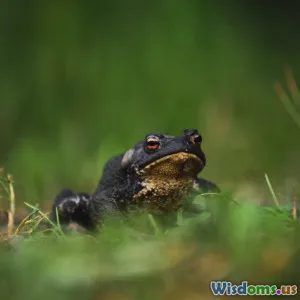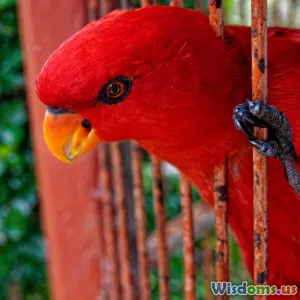
How Genetics Shapes Biodiversity
8 min read Explore how genetics underpins the rich tapestry of biodiversity within the animal kingdom. (0 Reviews)
How Genetics Shapes Biodiversity in the Animal Kingdom
Introduction: The Genesis of Life’s Variety
Biodiversity—the astonishing variety of life on Earth—is more than a spectacle of species; it is the product of countless genetic nuances and evolutionary processes. From the striking colors of a peacock’s feathers to the complex vocal patterns of whales, genetic diversity forms the underpinning of biological richness across animal species. Understanding how genetics shapes biodiversity not only reveals the intricate dance of life but also helps us protect dwindling ecosystems in an era of rapid environmental change.
The Genetic Blueprint of Biodiversity
Genetic Variation: The Foundation of Diversity
At its core, biodiversity hinges on genetic variation within and between populations. These genetic differences manifest in traits that influence survival and reproduction. For example, the peppered moth (Biston betularia) in England famously demonstrates how genetic variation affects population dynamics. During the Industrial Revolution, darker forms of the moth became predominant due to selective environmental pressures caused by soot deposits, illustrating natural selection acting on existing genetic variation.
Beyond phenotypic traits, genetic variation is essential for adapting to new threats such as diseases, climate change, and habitat destruction. Species with low genetic variability, like the cheetah (Acinonyx jubatus), are more vulnerable to extinction because their reduced genetic pool limits adaptability.
Mutation: The Source of Novelty
Genetic mutations introduce fresh material for evolution, providing new alleles that might confer advantages or disadvantages. Although many mutations are neutral or harmful, occasionally, some empower species with beneficial traits that enhance survival. For example, some populations of Anopheles mosquitoes have developed genetic resistance to insecticides, enabling them to survive human control measures and complicate malaria eradication efforts.
Mutations occurring in reproductive cells are particularly critical as they can be passed to future generations, thereby contributing to long-term genetic diversity.
Genetics and Evolutionary Mechanisms Driving Biodiversity
Natural Selection: Survival of the Genetically Fittest
Natural selection filters genetic variants by environmental suitability. Organisms with advantageous genetic traits tend to survive longer and reproduce more effectively, disseminating these traits widely. Darwin’s finches in the Galápagos Islands illustrate this process profoundly. Different populations exhibit distinct beak shapes adapted to available food sources, a result of selective pressures acting on genetic variation.
Genetic Drift: Randomness Speaks
Not all genetic changes arise from environmental pressures. Genetic drift is the random fluctuation of allele frequencies, particularly in small populations, which can lead to the fixation or loss of alleles over time. In isolated animal populations on islands or fragmented habitats, genetic drift may cause rapid genetic divergence, contributing to speciation and broader biodiversity. For example, island foxes (Urocyon littoralis) have diversified into distinct subspecies owing to genetic drift in isolated environments.
Gene Flow: Connecting Populations
Gene flow—the exchange of genetic material between populations—prevents genetic isolation and maintains diversity within species ranges. Migration of individuals facilitates this process. For instance, salmon (genus Oncorhynchus) returning to their natal rivers mix genetic material between populations, mitigating inbreeding and promoting resilience.
The Role of Genetics in Speciation
Speciation, the formation of new species, is a fundamental driver of biodiversity. Genetic changes accumulated over generations can lead to reproductive isolation. There are several modes:
-
Allopatric Speciation: Physical barriers such as mountains or rivers separate populations, causing genetic divergence. The diverse cichlid fishes of Africa’s Rift Lakes stemmed from such separations.
-
Sympatric Speciation: Genetic changes cause reproductive barriers within the same geographic area. Some insects develop preferences for different host plants, reducing gene flow and promoting speciation.
-
Hybridization: Genetic exchange between species can sometimes create hybrid species, increasing biodiversity. The fertile offspring of certain wolf and coyote populations illustrate this complex genetic admixture.
Genetics in Conservation: Safeguarding Biodiversity
Understanding genetics provides invaluable tools for conserving rare and endangered species. Conservation genetics assesses genetic diversity, inbreeding levels, and population structure to devise strategies that preserve or restore genetic health.
Take the example of the Florida panther (Puma concolor coryi), which faced inbreeding depression due to a critically small population. Conservationists introduced individuals from Texas to increase genetic variability, resulting in healthier offspring and population recovery.
Moreover, cutting-edge methods like CRISPR gene editing and genetic rescue efforts open new horizons for conserving genetic diversity amid threats like habitat loss and climate change.
The Future: Genetics as the Key to Biodiversity Resilience
As we confront the Anthropocene's environmental challenges, genetics offers vital insights to bolster biodiversity resilience. Climate change imposes new selective pressures, and species with richer genetic pools stand better chances for survival. Furthermore, genomic technologies enable rapid assessment and monitoring of genetic diversity, facilitating proactive conservation.
Inspiring Action Through Genetic Awareness
Learning how genetics shapes biodiversity empowers us to appreciate and protect life’s complexity. The next time you admire the intricate patterns on butterfly wings or listen to birds' songs, remember the vast genetic orchestra playing behind the scenes.
Conclusion: The Genetic Tapestry of Life
Genetics is undeniably the fundamental architect of biodiversity in the animal kingdom. From the generation of variation to the forces guiding species evolution, genetics molds life’s diversity and adaptability. Protecting this genetic heritage is not merely a scientific responsibility but a moral imperative to ensure the persistence of nature’s grandeur for future generations. As we continue to unravel genetic mysteries, fostering a harmonious coexistence with the biosphere becomes increasingly attainable and necessary.
“In the hidden dances of DNA lie the stories of life’s resilience and endless wonder.” — Unknown
Rate the Post
User Reviews
Popular Posts




















